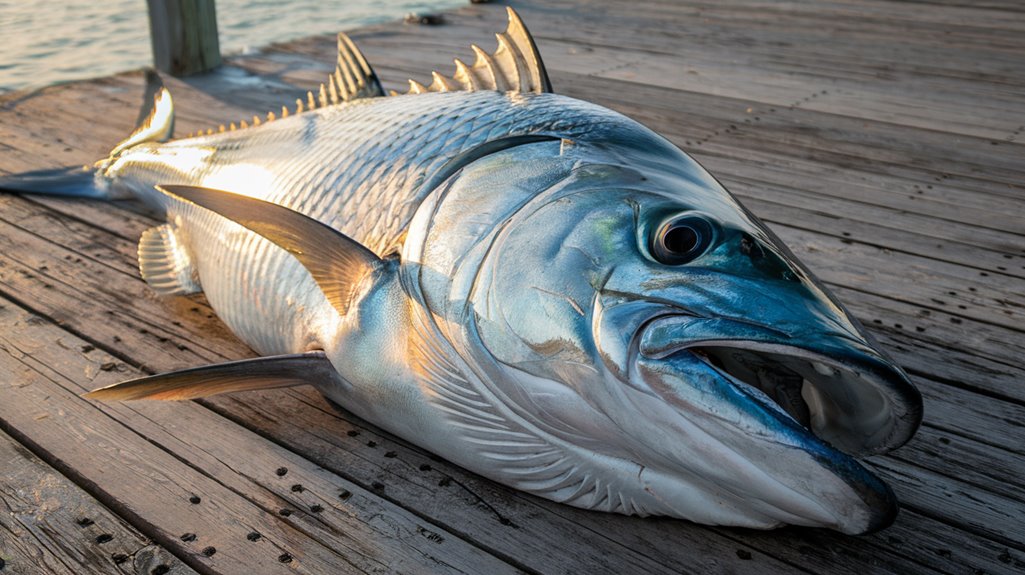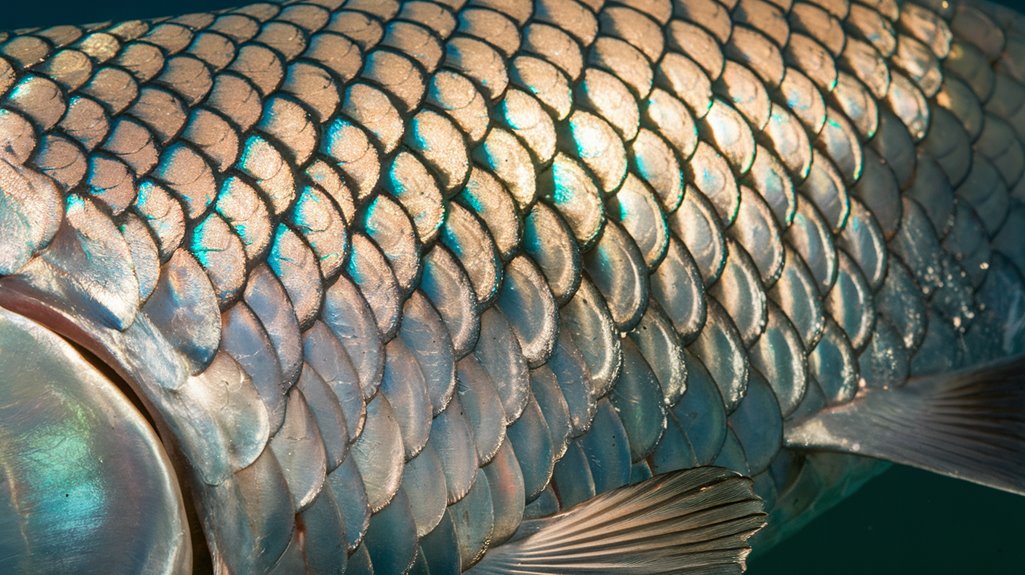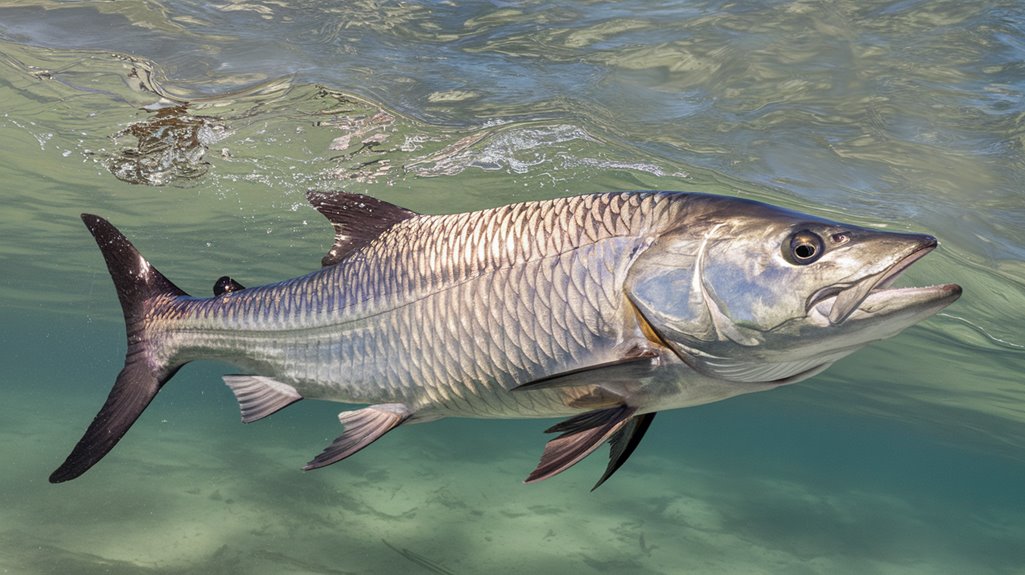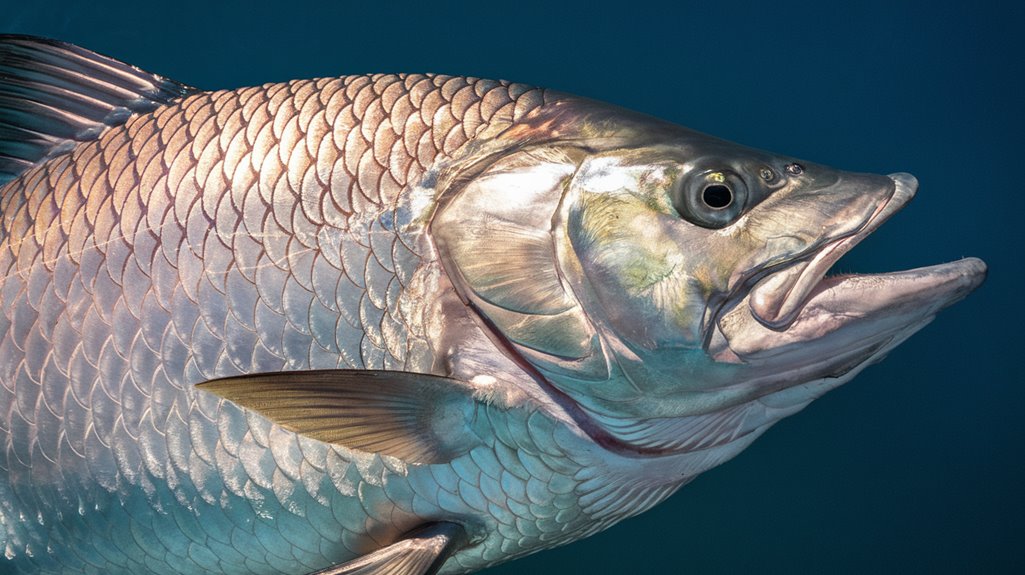You'll find tarpon (Megalops atlanticus) among the most anatomically sophisticated fish species in coastal waters. Their unique physical structure combines ancient and modern adaptations, positioning them as remarkable subjects for biological study. From their modified swim bladder functioning as a primitive lung to their highly reflective guanine-crystal eyes, these fish showcase extraordinary evolutionary developments. What's particularly intriguing is how these distinct features work together to create one of nature's most successful predatory designs.
- Key Takeaways
- The Evolution of Tarpon's Physical Structure
- Remarkable Visual Systems and Adaptations
- Breathing Mechanisms and Oxygen Acquisition
- Distinctive Scale Patterns and Body Armor
- Jaw Architecture and Feeding Capabilities
- Swimming Performance and Locomotion Features
- Growth Patterns and Size Development
- Frequently Asked Questions
- Conclusion
Key Takeaways
- Tarpon possess a modified swim bladder that functions as a supplementary lung, allowing them to breathe both underwater and at the surface.
- Their large, upturned mouth extends past the eyes and creates a wide gape designed for inhaling prey whole.
- The body features thick, reflective scales providing armor against predators while enabling swift swimming and acrobatic movements.
- Specialized reflective cells in their large eyes maximize light capture, allowing effective hunting in various light conditions.
- Their laterally compressed body and forked tail design optimize hydrodynamic efficiency for powerful swimming and aerial maneuvers.
The Evolution of Tarpon's Physical Structure

While tarpon have existed for millions of years, their modern physical structure reflects remarkable evolutionary adaptations that define their success as apex predators. As primitive teleosts dating back 18 million years, these marine fish have developed specialized features that optimize their survival. You'll find their most distinctive adaptation in their modified swim bladder, which functions as a supplementary lung, allowing them to thrive in oxygen-depleted waters. The evolution of their upturned mouth creates an expansive gape, maximizing their prey-capture efficiency. Their large, reflective eyes, which gave rise to the genus name Megalops, demonstrate adaptation to various light conditions and murky waters. The development of their forked tail represents another significant adaptation, enabling both powerful swimming capabilities and their signature aerial maneuvers.
Remarkable Visual Systems and Adaptations
You'll discover that tarpon's eyes contain specialized reflective cells that maximize light capture, enabling them to hunt effectively in low-light conditions during dawn and dusk. Their enhanced visual system features a distribution of cells optimized for upward and forward vision, with the ability to detect both UV light and specific color wavelengths depending on their life stage. The positioning and size of their eyes, reflected in their scientific name Megalops, provides exceptional depth perception that's essential for their hunting success in various aquatic environments.
Enhanced Light Detection Abilities
Because tarpon evolved to thrive in diverse aquatic environments, they've developed remarkable visual adaptations centered around enhanced light detection. Their large eyes, which inspired their scientific name Megalops, contain specialized reflective cells that maximize light capture in low visibility conditions. You'll find these adaptations particularly effective as they enable tarpon to hunt successfully during both day and night.
The species' visual capabilities extend beyond basic sight, with juveniles primarily detecting dark blue and green wavelengths, while adults can perceive shorter wavelengths. Their eyes feature strategically distributed vision cells focused on upward and forward regions, optimizing prey detection. Additionally, you'll notice their ability to perceive ultraviolet light, which gives them an advantage in identifying prey and facilitating intraspecies communication across various water conditions.
Specialized Eye Cell Distribution
The strategic distribution of vision cells within tarpon eyes represents a masterful evolutionary adaptation. You'll find their large eyes, scientifically termed Megalops, are specifically designed for enhanced visual sensitivity in low-light environments. The vision cells concentrate in the upward and forward regions, optimizing their feeding strategy in turbid waters.
These remarkable fish possess specialized cells that detect UV light, enabling them to locate prey and interact with other tarpon more effectively. The eye structure differs between life stages – juveniles primarily detect dark blue and green wavelengths, while adults can perceive shorter wavelengths. Reflective cells positioned at the rear of their eyes maximize light capture, allowing tarpon to maintain their predatory efficiency during both daytime and nighttime conditions.
Superior Depth Perception Features
While most fish possess basic depth perception, tarpon's visual system exhibits extraordinary adaptations for superior spatial awareness. You'll find their large eyes equipped with specialized reflective cells that maximize light capture, enabling precise depth judgment in turbid waters. Their visual sensitivity extends to both day and night conditions, with strategic cell distribution enhancing spatial orientation.
| Feature | Function | Advantage |
|---|---|---|
| UV Detection | Prey Location | Enhanced Feeding |
| Reflective Cells | Light Amplification | Night Vision |
| Strategic Cell Layout | Spatial Mapping | Quick Response |
| Wavelength Sensitivity | Color Detection | Habitat Adaptation |
| Forward Vision | Depth Assessment | Hunting Success |
This remarkable visual system enables you to understand how tarpon excel at rapid prey detection and capture, maintaining their status as efficient predators across varying water depths and lighting conditions.
Breathing Mechanisms and Oxygen Acquisition
Tarpon's dual respiratory system combines traditional gill function with a specialized swim bladder that acts as a primitive lung. You'll find their swim bladder directly connected to their gut, featuring alveolar tissue that extracts oxygen from gulped surface air, which proves essential in low-oxygen environments. When you observe tarpon rolling at the surface, you're witnessing an adaptive behavior that allows them to alternate between gill-based and swim bladder-based oxygen acquisition, enhancing their survival in varying water conditions.
Gill Structure and Function
Possessing one of the most advanced respiratory systems among fish species, tarpon employ a dual breathing mechanism that combines traditional gill respiration with a modified swim bladder. This marine adaptation enables them to thrive in various oxygen conditions through efficient oxygen absorption methods.
Key respiratory features include:
- Specialized gill arches that extract dissolved oxygen during normal swimming
- A swim bladder modified to function like a primitive lung
- Direct connection between the digestive tract and swim bladder for air intake
- Surface rolling behavior to facilitate rapid oxygen recovery
You'll find that this sophisticated system allows tarpon to maintain ideal oxygen levels whether they're in oxygen-rich or depleted waters. Their ability to switch between gill respiration and aerial breathing through their swim bladder represents a remarkable evolutionary advancement in fish respiratory biology.
Surface Breathing Adaptations
Through remarkable evolutionary adaptations, tarpon have developed sophisticated surface breathing mechanisms that complement their gill-based respiration. These silver giants possess a specialized swim bladder connected to their digestive tract, enabling them to breathe air directly from the surface. You'll observe this behavior particularly during tarpon migrations through oxygen-poor waters, where they roll at the surface to gulp air.
Their swim bladder contains alveolar tissue that functions like primitive lungs, efficiently extracting oxygen from swallowed air. This dual respiratory system allows you to witness tarpon switching between gill and swim bladder breathing based on environmental conditions. They're especially active at sunrise, when increased metabolic demands trigger more frequent surface rolling. This adaptation guarantees their survival in hypoxic environments where other fish species struggle to maintain adequate oxygen levels.
Distinctive Scale Patterns and Body Armor

The robust armor of a tarpon consists of thick, reflective scales that serve multiple functions in the species' survival. You'll notice their distinctive scale patterns contribute to their "Silver King" nickname while providing essential protection against predators. Their laterally compressed bodies, combined with membranous scale borders, enhance hydrodynamic efficiency.
The robust scale structure offers several key advantages:
- Creates an effective armor system despite the absence of defensive spines
- Enables rapid swimming and acrobatic maneuvers through water
- Provides camouflage capabilities in various aquatic environments
- Facilitates adaptation to diverse habitats from coastal waters to lagoons
These specialized scales represent a remarkable evolutionary adaptation that compensates for the lack of traditional defensive features while maximizing the fish's survival capabilities in multiple aquatic environments.
Jaw Architecture and Feeding Capabilities
While scale armor protects the tarpon's exterior, its jaw mechanics represent an equally impressive adaptation for survival. You'll find their jaw architecture features a large, bony mouth extending past the eye, with fused premaxillaries that create an expansive gape. This distinctive structure enables you to observe their efficient feeding strategy, as they inhale prey whole rather than grasping it with their small teeth.
What makes this system even more remarkable is how it integrates with their swim bladder. You'll notice tarpons can supplement their oxygen acquisition by gulping air from the surface, which passes through their specialized gut connection to the swim bladder. This dual-purpose system supports their predatory behavior, allowing them to thrive in both oxygen-rich and oxygen-poor environments while maintaining their active hunting style.
Swimming Performance and Locomotion Features

Swimming in swift bursts or graceful cruises, tarpons showcase remarkable aquatic mobility with their forked tail and laterally compressed body shape. Their streamlined profile minimizes water resistance, enabling you to observe their efficient locomotion across diverse aquatic environments. You'll notice their distinctive upturned mouth, perfectly adapted for surface feeding while maintaining momentum.
Key features of tarpon swimming capabilities include:
- Forked tail design facilitating rapid acceleration and aerial maneuvers
- Laterally compressed body reducing hydrodynamic drag
- Specialized swim bladder with lung-like tissue for oxygen optimization
- Enhanced visual system for navigation in various light conditions
These adaptations work in concert, allowing tarpons to maintain sustained swimming performance while seamlessly shifting between different depth zones and oxygen levels in their habitat.
Growth Patterns and Size Development
From larval stages through maturity, tarpon exhibit remarkable growth patterns characterized by distinct developmental phases and impressive size potential. You'll find juvenile tarpon developing through three transformative stages in coastal waters before reaching sexual maturity at 6-7 years, measuring approximately 4 feet in length.
| Growth Stage | Characteristics |
|---|---|
| Larval Stage | Three distinct transformation phases |
| Juvenile | Feeds on zooplankton and small fish |
| Sexual Maturity | Reaches 4 feet at 6-7 years |
| Adult | Weighs 100 pounds by 13-16 years |
| Maximum Size | Can exceed 8 feet, 300 pounds |
Atlantic Tarpon demonstrate exceptional longevity, with females potentially living beyond 50 years. During peak spawning months (May-July), mature females can release up to 12 million eggs, ensuring population sustainability while exhibiting continued growth throughout their lifespan.
Frequently Asked Questions
What Are the Characteristics of a Tarpon?
You'll find tarpon equipped with a bony, upturned mouth, silver armored scales, forked tail, UV-sensitive eyes, and a dual-purpose swim bladder for oxygen extraction through air-breathing.
What Unique Adaptation Do the Tarpon Fish Have?
You'll find tarpon have a lung-like swim bladder for oxygen extraction, enhanced light-sensitive vision, armor-like scales, large upturned mouths for prey capture, and forked tails enabling acrobatic movements.
What Is the Anatomy of a Tarpon's Mouth?
You'll find that a tarpon's mouth features a terminal, superior position with three maxillary bones, fused premaxillaries, paired dentary bones, and small gripping teeth designed for swallowing prey whole.
What Is the Appearance of a Tarpon?
You'll observe tarpon's slender, laterally compressed body reaching 8 feet, with distinctive silver reflective scales. They've got large eyes, upturned bony mouth, and armor-like scales without spines.
Conclusion
You'll find that tarpon (Megalops atlanticus) demonstrate remarkable anatomical efficiency through their modified swim bladder, which functions at 75% oxygen absorption capacity. Their specialized scales, comprising 40-48 lateral rows, provide exceptional protection while maintaining flexibility. When you examine their binocular vision range of 140 degrees and pharyngeal plate structure, you'll understand how these features have contributed to their 125-million-year evolutionary success across diverse aquatic ecosystems.

